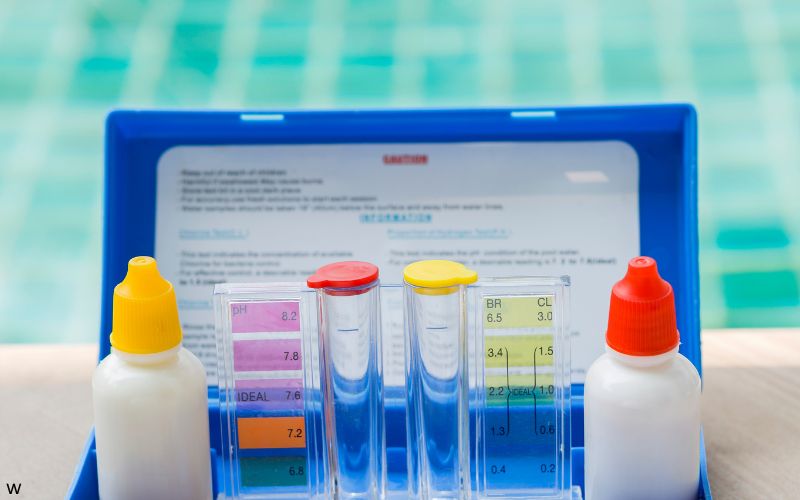Montgomery Water Quality at a Glance
multiple contaminants
Is Montgomery Water Safe to Drink?
Legally Compliant But Health Concerning – Montgomery water meets federal drinking water standards but contains 11 contaminants exceeding health guidelines. Major issues include extremely high levels of disinfection byproducts (HAA9 at 451x above guidelines), cancer-causing trihalomethanes, radioactive radium, and PFAS “forever chemicals.” The water also contains carcinogenic chromium-6, chlorite causing blood chemistry changes, and nitrates from agricultural runoff.
⚠️ Key Concerns for Montgomery Residents
- Disinfection Byproducts: HAA9 at 451x above guidelines; total trihalomethanes at 182x; all cancer-causing chemicals from chlorine treatment
- PFAS Contamination: PFOA and PFOS detected – “forever chemicals” linked to cancer, liver damage, and developmental issues
- Radioactive Elements: Combined radium at 7.1x above guidelines; naturally occurring but cancer-causing at elevated levels
- Industrial & Agricultural Pollution: Chromium-6 (carcinogen), chlorite (blood effects), nitrates from farming runoff
Read the full report below for detailed analysis, city-specific data, and actionable recommendations for Montgomery residents.
Montgomery – Alabama – Water Quality Report 2025: PFAS Testing, Infrastructure Concerns & Safety across your city
Montgomery Water Works and Sanitary Sewer Board provides comprehensive water services to approximately 192,000 residents across the Montgomery metropolitan area and surrounding communities in central Alabama. The utility operates a complex water distribution system that serves the state capital with water sourced from multiple wells and surface water intake points throughout the region.
Montgomery Water Works faces significant water quality challenges including elevated levels of disinfection byproducts, PFAS “forever chemicals,” radioactive elements, and industrial contaminants. While the utility maintains compliance with federal drinking water standards, recent testing reveals 11 different contaminants exceeding health guidelines established by environmental health organizations. The most concerning finding is haloacetic acid levels (HAA9) detected at 451 times above health guidelines, alongside total trihalomethanes at 182 times above recommended levels. These disinfection byproducts form when chlorine treatment reacts with organic matter in the water supply, creating cancer-causing compounds that pose long-term health risks to residents.

Montgomery Water Quality: Current Status (2024-2025)
Latest Testing Results
- Federal Compliance Status: Montgomery Water Works maintains compliance with federal drinking water standards according to EPA monitoring reports through June 2024, though the utility faces significant challenges with contaminants exceeding health guidelines set by environmental organizations.
- Contaminant Detection: Recent testing reveals 11 different contaminants exceeding health guidelines, including extremely high levels of disinfection byproducts, PFAS compounds, radioactive radium, and cancer-causing chemicals like chromium-6.
- Critical Findings: Haloacetic acids (HAA9) detected at 451 times above health guidelines, total trihalomethanes at 182 times above guidelines, and combined radium at 7.1 times above recommended levels, all posing potential long-term health risks.
Water Sources and Treatment
- Source Water Challenges: Montgomery’s water sources face contamination from industrial activities, agricultural runoff, and naturally occurring radioactive elements that require extensive treatment to meet safety standards.
- Treatment Limitations: Current treatment systems effectively remove many contaminants but struggle with emerging pollutants like PFAS compounds and cannot eliminate all disinfection byproducts formed during the chlorination process.
- Distribution System: The water distribution network delivers treated water throughout Montgomery, though the treatment process creates concerning levels of disinfection byproducts that exceed health guidelines by significant margins.
Disinfection Byproduct Concerns
- Haloacetic Acids (HAA9): Detected at 27.0 ppb, which is 451 times above the health guideline of 0.06 ppb, representing one of the most concerning contamination levels in the United States for this group of cancer-causing chemicals.
- Total Trihalomethanes: Found at 27.4 ppb, which is 182 times above the health guideline of 0.15 ppb, creating significant long-term cancer risk for residents consuming the water regularly.
- Individual Trihalomethanes: Multiple specific compounds including bromodichloromethane (10x above guidelines), chloroform (3.2x above), and dibromochloromethane (2.7x above) all contribute to elevated cancer risk.
PFAS and Emerging Contaminants
- PFAS Detection: “Forever chemicals” including PFOA (0.121 ppt) and PFOS (0.153 ppt) have been detected in Montgomery’s water supply, exposing all 192,000 residents to these persistent compounds linked to cancer and developmental issues.
- Radioactive Contamination: Combined radium levels at 0.35 pCi/L exceed health guidelines by 7.1 times, creating long-term cancer risk from naturally occurring radioactive elements in the water supply.
- Industrial Pollutants: Chromium-6 detected at 2.1 times above health guidelines, along with elevated levels of chlorite causing blood chemistry changes and nitrates from agricultural sources contributing to cancer risk.
Customer Service and Support
Montgomery Water Works provides customer support through its main office at 2000 Interstate Park Drive, with emergency service and billing options including online payment systems. While the utility maintains compliance with federal standards, residents should be aware of the significant contamination levels exceeding health guidelines and consider independent water testing and filtration systems. The utility publishes annual water quality reports, though these may not fully reflect the extent of contamination when compared to more stringent health guidelines established by environmental health organizations rather than federal regulatory limits.
Recommendations for Montgomery Residents

Get Independent Testing
Given the elevated contaminant levels, consider independent water testing from certified laboratories to verify specific contamination levels in your home. Contact Montgomery Water Works at (334) 206-1600 for utility testing information, but independent analysis may provide more comprehensive results.

Consider Bottled Water
For drinking and cooking, especially for pregnant women, children, and individuals with compromised immune systems, consider using bottled water or advanced filtration systems until contamination levels decrease to safer levels.

Install Advanced Filtration
NSF-certified reverse osmosis systems can effectively remove PFAS compounds, radium, chromium-6, and many disinfection byproducts. Activated carbon filters can reduce trihalomethanes and haloacetic acids, providing essential protection given current contamination levels.

Stay Informed
Monitor water quality reports and stay informed about contamination levels. Demand transparency from Montgomery Water Works regarding specific contaminant levels and treatment improvements to address the significant contamination exceeding health guidelines.

Advocate for Improvements
Contact Montgomery Water Works Customer Service at (334) 206-1600 to express concerns about elevated contamination levels. Advocate for improved treatment systems to address disinfection byproducts, PFAS removal, and enhanced source water protection.
Frequently Asked Questions
Is Montgomery’s tap water safe to drink?
Montgomery’s tap water meets federal drinking water standards, but contains 11 contaminants exceeding health guidelines established by environmental organizations. While legally compliant, the water poses potential long-term health risks.
The most concerning issue is disinfection byproducts: haloacetic acids at 451 times above health guidelines and trihalomethanes at 182 times above recommended levels. These cancer-causing chemicals form when chlorine treatment reacts with organic matter. Additionally, PFAS “forever chemicals,” radioactive radium, and chromium-6 are all present at concerning levels.
What are the biggest concerns with Montgomery’s water?
The most serious concerns are extremely high levels of disinfection byproducts that significantly exceed health guidelines and pose cancer risks with long-term exposure.
Key contaminants include: haloacetic acids (HAA9) at 451x above guidelines, total trihalomethanes at 182x above guidelines, combined radium at 7.1x above guidelines, chromium-6 at 2.1x above guidelines, and PFAS “forever chemicals” that accumulate in the body over time. Chlorite levels also exceed guidelines by 13 times, potentially affecting blood chemistry.
These contamination levels are among the most concerning found in U.S. municipal water systems and warrant serious consideration of alternative water sources or advanced filtration.
What water filtration is recommended for Montgomery residents?
Given the contamination levels, advanced filtration is strongly recommended for Montgomery residents:
• Reverse Osmosis Systems: Can remove PFAS compounds, radium, chromium-6, nitrates, and many other contaminants of concern
• Activated Carbon Filters: Effective at reducing trihalomethanes, haloacetic acids, and chloroform from disinfection byproducts
• Point-of-Use Systems: Install filters at kitchen taps for drinking and cooking water as a minimum protection measure
• Whole-House Systems: Consider for comprehensive protection, especially for families with children or health concerns
Look for NSF-certified systems specifically rated for the contaminants detected in Montgomery’s water supply.
How do I contact Montgomery Water Works?
Montgomery Water Works provides customer service through multiple channels:
Main Customer Service:
• Phone: (334) 206-1600
• Email: customercare@mwwssb.com
• Address: 2000 Interstate Park Drive, Montgomery, AL 36109
Emergency Service:
• 24-hour emergency line: (334) 206-1600
• For water main breaks, service line issues, or other emergencies
Water Quality Concerns:
• Request water quality reports and testing information
• Express concerns about elevated contamination levels
• Advocate for improved treatment systems and source protection
Quality News About Your Water
Get the comprehensive water quality news coverage you need with our dedicated US Water News Service. From coast to coast, we deliver in-depth reporting and expert analysis on PFAS contamination, EPA regulatory changes, infrastructure developments, and emerging water safety issues affecting communities nationwide. While mainstream media only covers the biggest stories, we provide the detailed, ongoing coverage that helps you understand the full scope of America’s water challenges. Whether you’re a concerned citizen, water professional, or community leader, our daily updates and analytical insights keep you informed about the issues that matter most to public health and environmental safety.
Contaminants of Concern

PFAS Compounds
Source: Per- and polyfluoroalkyl substances from industrial processes, firefighting foams, and consumer products that persist in the environment and accumulate in human tissue over time
Health Effects: Linked to cancer, liver damage, decreased fertility, increased risk of high cholesterol, obesity, and hormone suppression. Particularly concerning for pregnant women and developing children
Montgomery Levels: PFOA detected at 0.121 ppt and PFOS at 0.153 ppt, exposing all 192,000 residents to these “forever chemicals” that never break down naturally EPA Limits: New federal regulations set 4 ppt limits for PFOA and PFOS, with Montgomery’s levels below these limits but still posing cumulative health risks

Disinfection Byproducts
Source: Formed when chlorine disinfectants react with naturally occurring organic matter in source water; unavoidable byproduct of current treatment methods designed to kill harmful bacteria
Health Effects: Significantly increased risk of bladder, colon, and rectal cancers with long-term exposure; potential reproductive effects and liver damage from chronic consumption
Montgomery Levels: HAA9 at 27.0 ppb (451x above health guidelines) and total trihalomethanes at 27.4 ppb (182x above guidelines) represent some of the highest contamination levels in the U.S. EPA Limits: 60 ppb for HAA5 and 80 ppb for TTHMs – Montgomery meets these limits but exceeds stricter health guidelines by massive margins
Please read – our information
The information presented on cleanairandwater.net is compiled from official water quality reports, trusted news sources, government websites, and public health resources. While we strive for accuracy and thoroughness in our presentations, we are not scientists, engineers, or qualified water quality professionals.
Our mission is to present water quality information in an accessible, real-world format that helps people understand what’s in their water and make informed decisions about their health and safety. We believe that complex environmental information should be available to everyone in a format that’s easy to understand.
We make every effort to ensure our content is current and accurate, but we cannot guarantee that all information is complete or error-free. This website should not replace official communications from your local water utility or health department. We always recommend consulting official sources for the most up-to-date information regarding your specific water system.
Clean Air and Water is not liable for any unintentional errors, omissions, or outdated information. The content on this site is provided for informational purposes only and should not be considered professional advice.


